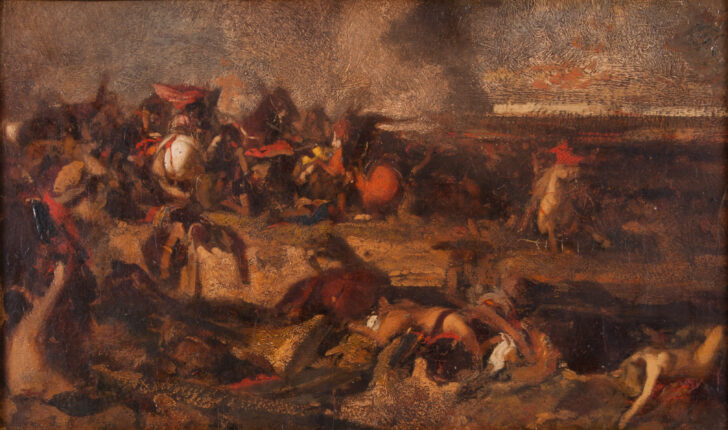Study for The Defeat of the Cimbri (Étude: La Défaite des Cimbres)
Alexandre-Gabriel Decamps

Description
March 28, 2009
This sketch belongs to a larger composition depicting the defeat of the Germanic tribe of the Cimbri, near the present city of Aix-en-Provence in southern France, by the Roman consul Marius in 101 BCE. Paintings of military history were in vogue during this period, and the painting, finished in 1833, was exhibited in the official Salon of 1834, where it won a prize for the artist. However, the award was not within the category of history painting but in the less-esteemed classification of “landscapes and marines”—awarded by a jury that had difficulty assessing Decamps’ work because it simply didn’t align with prevailing artistic standards.
In this oil sketch, the sweeping vista of the finished work is distilled to a segment of the battle that occupies the middle ground. Decamps’ dense application of paint is nevertheless freely handled, finding in the loose handling a visual equivalent to the emotion valued by progressive French painting of the time. A study in the massing of figures, the horses and men engaged in combat, recalls the works of Decamps’ contemporary Delacroix, whose scenes of fighting display the same warm palette and with whom Decamps came to share leadership of the French school of painting.
*Gallery Rotation Winter 2011 (January 2011)
Alexandre-Gabriel Decamps
France, 1803–1860
Study for The Defeat of the Cimbri
before 1834
Oil on canvas
The Paul Leroy Grigaut Memorial Collection, 1969/2.94
This sketch belongs to a larger composition depicting the defeat of the Germanic tribe of the Cimbri, near the present city of Aix-en-Provence in southern France, by the Roman consul Marius in 101 bce. Paintings of military history were in vogue during this period, and the painting, finished in 1833, was exhibited in the official Salon of 1834, where it won a prize for the artist. However, the award was not within the category of history painting but in the less-esteemed classification of “landscapes and marines”—awarded by a jury that had difficulty assessing Decamps’ work because it simply didn’t align with prevailing artistic standards.
In this oil sketch, the sweeping vista of the finished work is distilled to a segment of the battle that occupies the middle ground. Decamps’ dense application of paint is nevertheless freely handled, finding in the loose handling a visual equivalent to the emotion valued by progressive French painting of the time. A study in the massing of figures, the horses and men engaged in combat, recalls the works of Decamps’ contemporary Delacroix, whose scenes of fighting display the same warm palette and with whom Decamps came to share leadership of the French school of painting.
Gallery Rotation Winter 2011
Alexandre-Gabriel Decamps
France, 1803–1860
Study for The Defeat of the Cimbri
before 1834
Oil on canvas
The Paul Leroy Grigaut Memorial Collection, 1969/2.94
This sketch belongs to a larger composition depicting the defeat of the Germanic tribe of the Cimbri, near the present city of Aix-en-Provence in southern France, by the Roman consul Marius in 101 bce. Paintings of military history were in vogue during this period, and the painting, finished in 1833, was exhibited in the official Salon of 1834, where it won a prize for the artist. However, the award was not within the category of history painting but in the less-esteemed classification of “landscapes and marines”—awarded by a jury that had difficulty assessing Decamps’ work because it simply didn’t align with prevailing artistic standards.
In this oil sketch, the sweeping vista of the finished work is distilled to a segment of the battle that occupies the middle ground. Decamps’ dense application of paint is nevertheless freely handled, finding in the loose handling a visual equivalent to the emotion valued by progressive French painting of the time. A study in the massing of figures, the horses and men engaged in combat, recalls the works of Decamps’ contemporary Delacroix, whose scenes of fighting display the same warm palette and with whom Decamps came to share leadership of the French school of painting.
Subject Matter:
A study for one of Decamps' most important works that was exhibitied in the Salon of 1834, this work depicts a battle in 101BCE of the Roman consul Marius against the Germanic tribe of the Cimbri. In palette and composition, this painting recalls the battle scenes of Delacroix.
Physical Description:
Densely painted, this painting depicts a battle with figures both on foot and on horseback. Fallen figures in the foreground are mirrored by a line of figures still engaged in combat in the futher distance. The rump of a white horse at the left is balanced by another pale horse and rider (with banner) that approaches the viewer at right.
Usage Rights:
If you are interested in using an image for a publication, please visit https://umma.umich.edu/request-image/ for more information and to fill out the online Image Rights and Reproductions Request Form.